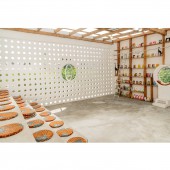
| THE AWARD |
| CATEGORIES |
| REGISTRATION |
| SUBMIT YOUR WORK |
| ENTRY INSTRUCTIONS |
| TERMS & CONDITIONS |
| PUBLICATIONS |
| DATES & FEES |
| METHODOLOGY |
| CONTACT |
| WINNERS |
| PRESS ROOM |
| GET INVOLVED |
| DESIGN PRIZE |
| DESIGN STORE |
| THE AWARD | JURY | CATEGORIES | REGISTRATION | PRESS | WINNERS | PUBLICATIONS | ENTRY INSTRUCTIONS |
Mariam's Library by Mai Al Busairi |
Home > Winners > Design #159941 >Interview |
 |
|
FS: What is the main principle, idea and inspiration behind your design?
MA: The main principle and inspiration behind our design is the commitment to giving back to both local and global communities through our Parallel Gives Program. As for the design, The design concept revolved around creating a space that seamlessly integrated traditional architectural elements with modern design principles, respecting Zanzibar's architectural heritage. It aimed to balance functionality with aesthetic appeal, ensuring the safety and well-being of the community while fostering a welcoming and inclusive environment conducive to learning, creativity, and community involvement.
FS: What has been your main focus in designing this work? Especially what did you want to achieve?
MA: The idea stemmed from the aim of providing enhanced educational opportunities to the students of Zanzibar, aligning with the curriculum while serving both Beit Ras School students and the Mwanyanya community.
FS: What are your future plans for this award winning design?
MA: Do more of the same nature of projects (Charity Projects)
FS: How long did it take you to design this particular concept?
MA: design and build took 34 days
FS: Why did you design this particular concept? Was this design commissioned or did you decide to pursuit an inspiration?
MA: It was driven by our commitment to social responsibility and our desire to make a positive impact on the community. It was not specifically commissioned; rather, it was born out of our inspiration to address educational needs in Zanzibar and contribute to the well-being of the Mwanyanya community. We pursued this concept as a way to give back and align our design expertise with a meaningful cause.
FS: Is your design being produced or used by another company, or do you plan to sell or lease the production rights or do you intent to produce your work yourself?
MA: Our intention was to create a space that serves the community's needs, and we remain open to future possibilities regarding the production or implementation of our design.
FS: What made you design this particular type of work?
MA: We designed this particular type of work to address the educational needs of the community in Zanzibar and contribute to their well-being.
FS: Where there any other designs and/or designers that helped the influence the design of your work?
MA: Sun, rain, wind and need were our inspiration to come up with the design
FS: Who is the target customer for his design?
MA: The community of Mwanyanya in Zanzibar and the students of Beit Ras School
FS: What sets this design apart from other similar or resembling concepts?
MA: thoughtful integration of traditional architectural elements with modern design principles, respecting Zanzibar's heritage. Additionally, the project's emphasis on community engagement and collaboration distinguishes it, as does its focus on sustainability and functionality
FS: How did you come up with the name for this design? What does it mean?
MA: It was the name of my friend's mom who passed away while she was in Zanzibar
FS: Which design tools did you use when you were working on this project?
MA: Rhino
FS: What is the most unique aspect of your design?
MA: Pre-cast bricks out of clay
FS: Who did you collaborate with for this design? Did you work with people with technical / specialized skills?
MA: My team at Parallel Studio
FS: What is the role of technology in this particular design?
MA: Only Rhino software
FS: Is your design influenced by data or analytical research in any way? What kind of research did you conduct for making this design?
MA: We studied local architectural styles and materials to incorporate elements that respected Zanzibar. also considering environmental factors and sustainability principles. Our research also involved gathering feedback from community members to understand their preferences and priorities, ensuring the design was tailored to their specific needs and aspirations.
FS: What are some of the challenges you faced during the design/realization of your concept?
MA: Balancing traditional architectural elements with modern design principles while respecting Zanzibar's architectural heritage.Time constraints due to being non-locals, requiring efficient project management and decision-making. Ensuring the safety and well-being of the team, particularly in the face of health challenges such as contagious diseases. Integrating sustainable construction techniques and materials while meeting project budget and timeline requirements. Overcoming logistical obstacles related to material sourcing, transportation, and on-site coordination in a remote location like Zanzibar.
FS: How did you decide to submit your design to an international design competition?
MA: A'design awards approached us luckily
FS: What did you learn or how did you improve yourself during the designing of this work?
MA: Enhanced problem-solving skills. Increased cultural sensitivity. Expanded sustainability knowledge. Strengthened resilience
FS: Any other things you would like to cover that have not been covered in these questions?
MA: No, thank you
FS: Thank you for providing us with this opportunity to interview you.
A' Design Award and Competitions grants rights to press members and bloggers to use parts of this interview. This interview is provided as it is; DesignPRWire and A' Design Award and Competitions cannot be held responsible for the answers given by participating designers.
| SOCIAL |
| + Add to Likes / Favorites | Send to My Email | Comment | View Press-Release |





